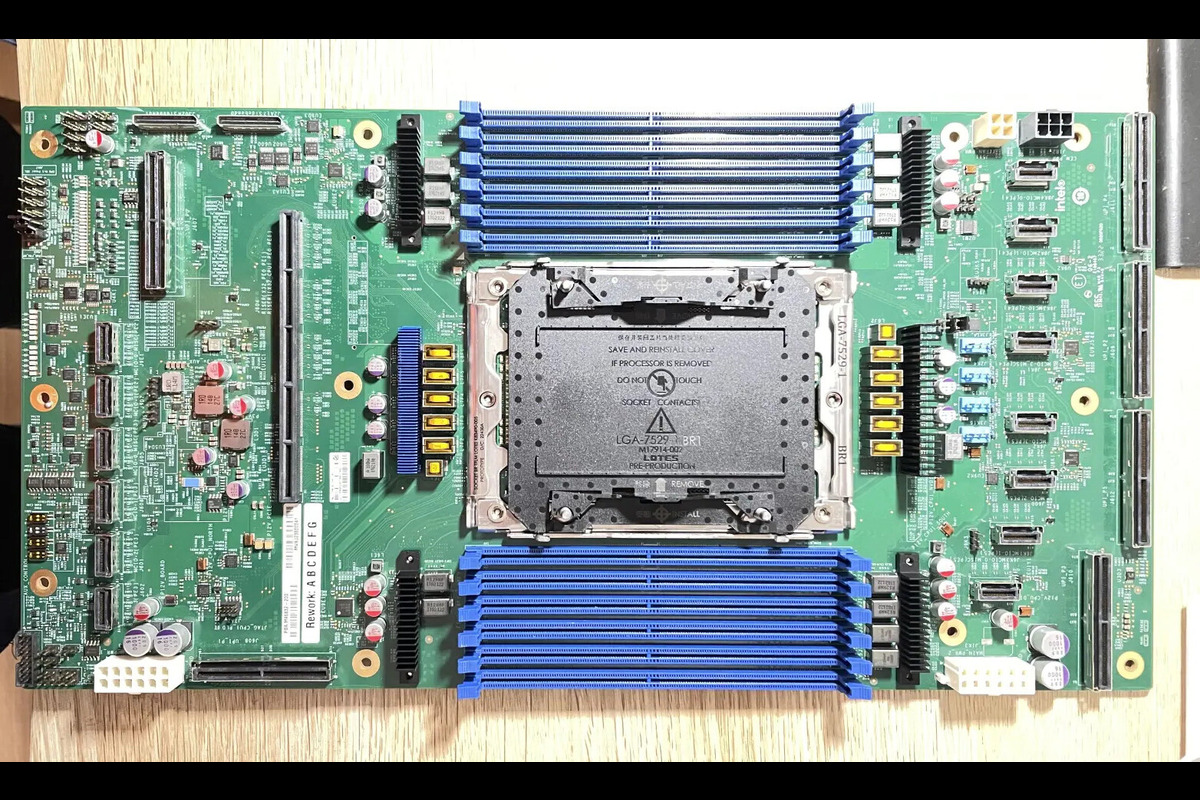Intel‘s Xeon processors are designed for use in servers and workstations and are known for their high performance and reliability.
Intel has developed various sockets to support its powerful CPUs over the years, often requiring new motherboards with each new socket. If legitimate, the rumored LGA 7529 socket could be a significant leap in CPU performance for workstations and servers, particularly for the upcoming Intel Mountain Stream platform. However, leaked images and rumors should be treated cautiously until officially confirmed. These authentic images could shed light on the capabilities of the LGA 7529 socket.
The fact that the motherboard in question is an engineering sample with the “ES” labeling suggests that it is still in the testing phase and not yet ready for release. As previously rumored, the LGA 7529 socket with the next-gen Granite Rapids and Sierra Forest chips could support up to 512 cores. However, it’s important to remember that until Intel confirms any official details about the platform or the socket, these rumors and leaks should be taken cautiously. In any case, developing a new socket design could indicate that Intel continues to push the boundaries of server and workstation performance and that we may see some significant advancements shortly.
If these rumors are true, the upcoming Xeon platform with the LGA 7529 socket could represent a significant leap forward in CPU performance for servers and workstations. Including P-Core variants with up to 86 and 132 cores and E-Core variants with up to 334 and 512 cores could provide a range of options for users with different performance needs and budgets. Additionally, including HBM (high-bandwidth memory) variants could help address the increasing demand for memory bandwidth in high-performance computing applications. HBM is a memory technology that provides the following:
- Significantly higher bandwidth than traditional DDR memory.
- Making it ideal for use in applications such as machine learning.
- Data analytics.
- Scientific simulations.
Additionally, these CPUs’ actual performance and capabilities will depend on various factors, including the specific implementation, cooling, and other system components. Suppose the leaked information about the LGA 7529 socket and the upcoming Xeon platform is accurate. In that case, the platform could support various cutting-edge technologies that significantly enhance server and workstation performance. PCIe Gen 5.0 is the latest generation of the PCIe interface and provides substantially higher bandwidth than PCIe Gen 4.0.
Leveraging 96 PCIe Gen 5 lanes, the LGA 7529 motherboard can efficiently support high-performance components like NVMe SSDs, GPUs, and network adapters. The memory-intensive applications could benefit significantly from the motherboard’s support for 12-channel DDR5-6400 memory and up to 24 RDIMM slots, offering unprecedented DRAM capacity.
DDR5 memory also offers higher speeds and lower power consumption than DDR4, which could further enhance performance and efficiency. If these rumored specifications are accurate, the upcoming Xeon platform with the LGA 7529 socket could significantly boost performance for server and workstation applications. If the leaked information about the LGA 7529 socket and the forthcoming Xeon platform is accurate, then the platform could significantly enhance interconnectivity and bandwidth.
Improving the Ultra Path Interconnect (UPI) technology for LGA 7529 socket motherboards could enhance the communication between CPUs, leading to better performance and scalability. Additionally, if Intel’s PCB connection outperforms AMD’s, it could provide an overall system performance and reliability advantage. However, the absence of a southbridge chip section may restrict the motherboard’s compatibility with specific hardware components.
A southbridge chip is typically used to manage input/output operations and other peripheral devices, such as hard drives and USB ports. If the motherboard lacks a southbridge chip, users may need additional hardware components or software drivers to handle these operations. The rumored enhancements to UPI and PCB connection could benefit the upcoming Xeon platform with the LGA 7529 socket. However, it’s important to remember that these are rumors and leaks and that performance and capabilities depend on various factors. The size of the LGA 7529 socket is a noteworthy difference compared to the LGA 4189 socket.
The LGA 7529 socket surpasses its pin density and size counterpart, enabling it to accommodate more CPUs, making it perfect for high-density computing and quick scalability. The PCIe 5.0 Mini Cool Edge IO connector, which supports UPI, PCIe, GENZ, and CEM, and offers reliable and speedy communication between various components, is a notable feature. Additionally, the high current capacity of the R2214914 VRMs is intriguing since it provides sufficient power to both the processor and memory.
With 105A, the VRMs could provide significant power to support high-performance applications. The rumored specifications of the Sierra Forest Xeon CPUs are impressive. With up to 528 cores, the chips could provide a substantial performance boost for high-density computing applications. However, it’s crucial to note that these are still rumors and leaks, and the actual performance and capabilities will depend on various factors.


